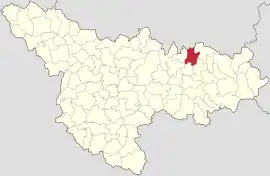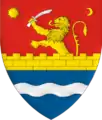Bara | |
|---|---|
.JPG.webp) St. George Orthodox church in Bara | |
 Location in Timiș County | |
 Bara Location in Romania | |
| Coordinates: 45°53′35″N 21°52′50″E / 45.8931°N 21.8806°E | |
| Country | Romania |
| County | Timiș |
| Government | |
| • Mayor (2020–2024) | Daniel Ursu[1] (PSD) |
| Area | 70.4 km2 (27.2 sq mi) |
| Population (2021-12-01)[3] | 299 |
| • Density | 4.2/km2 (11/sq mi) |
| Time zone | EET/EEST (UTC+2/+3) |
| Postal code | 307020–307024 |
| Vehicle reg. | TM |
| Website | www |
Bara (Hungarian: Barafalva; German: Barr) is a commune in Timiș County, Romania. It is composed of five villages: Bara (commune seat), Dobrești, Lăpușnic, Rădmănești and Spata. Bara is located in the northeast of Timiș County, in a hilly area, 70 km (43 mi) from Timișoara and 30 km (19 mi) from Lugoj.
History
The first recorded mention of Bara dates from 1367.[4] The name Bara is of Slavic origin and, in medieval documents, is associated with the description "terra acquosa", meaning a marshy land. In 1440 Bara is taken from the prefect of Timiș by King Vladislav I and given to the Șoimoș Fortress.[5] By 1477 it was the property of the prefect of Pozsony, Miklós Bánffy.[5] Under the Turks it was destroyed and re-established in 1690–1700. In 1879 Bara was bought by Pavel Teodorescu and Constantin Florea.[5] The village was Romanian and remained mostly Romanian during the Austro-Hungarian rule.[5]
All the villages in the commune were massively depopulated after World War II. Spata, for instance, became a ghost village in 1997 with the death of the last native. However, the settlement was repopulated by several families of Transylvanian shepherds.[5]
Demographics
Bara had a population of 388 inhabitants at the 2011 census, up 3% from the 2002 census. Most inhabitants are Romanians (97.94%). For 1.8% of the population, ethnicity is unknown.[6] By religion, most inhabitants are Orthodox (97.42%). For 1.8% of the population, religious affiliation is unknown.[7]
| Census[8] | Ethnic composition | |||
|---|---|---|---|---|
| Year | Population | Romanians | Hungarians | Germans |
| 1880 | 2,980 | 2,890 | 15 | 52 |
| 1890 | 2,857 | 2,809 | 36 | 11 |
| 1900 | 3,378 | 3,283 | 56 | 36 |
| 1910 | 3,381 | 3,289 | 37 | 37 |
| 1920 | 3,190 | 3,164 | 8 | 9 |
| 1930 | 3,105 | 3,066 | 9 | 25 |
| 1941 | 2,927 | 2,904 | 6 | 15 |
| 1956 | 2,633 | 2,620 | 8 | – |
| 1966 | 1,885 | 1,881 | 1 | 1 |
| 1977 | 816 | 811 | – | – |
| 1992 | 427 | 417 | 9 | – |
| 2002[9] | 378 | 367 | 8 | – |
| 2011 | 388 | 380 | – | – |
Notable people
- Daniel Ciobotea (b. 1951), Patriarch of the Romanian Orthodox Church (2007–present)
References
- ↑ "Results of the 2020 local elections". Central Electoral Bureau. Retrieved 16 June 2021.
- ↑ "Primăria Bara". Ghidul Primăriilor.
- ↑ "Populaţia rezidentă după grupa de vârstă, pe județe și municipii, orașe, comune, la 1 decembrie 2021" (XLS). National Institute of Statistics.
- ↑ Szabó, M. Attila (2003). Erdély, Bánság és Partium történeti és közigazgatási helységnévtára. Miercurea Ciuc: Pro-Print Kiadó.
- 1 2 3 4 5 "Fișa Primăriei comunei Bara". Consiliul Județean Timiș.
- 1 2 "Tab8. Populația stabilă după etnie – județe, municipii, orașe, comune". Institutul Național de Statistică. Archived from the original on 2016-01-18. Retrieved 2021-09-04.
- 1 2 "Tab13. Populația stabilă după religie – județe, municipii, orașe, comune". Institutul Național de Statistică. Archived from the original on 2020-08-07. Retrieved 2021-09-04.
- ↑ Varga, E. Árpád. "Temes megye településeinek etnikai (anyanyelvi/nemzetiségi) adatai 1880-1992" (PDF).
- ↑ "Bara / Barafalva". Structura etno-demografică a României. Centrul de Resurse pentru Diversitate Etnoculturală.
